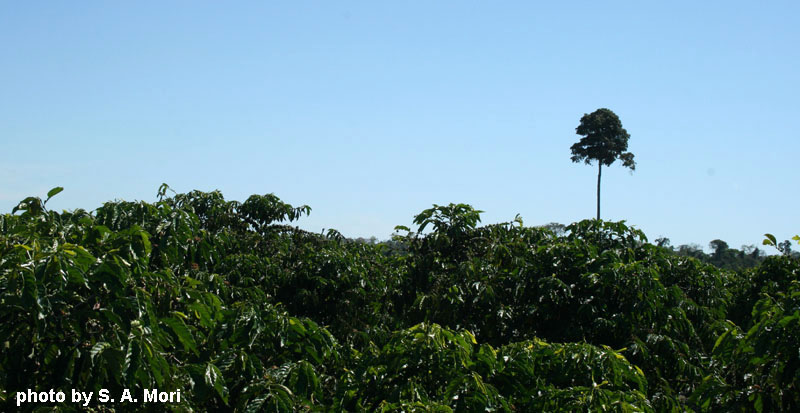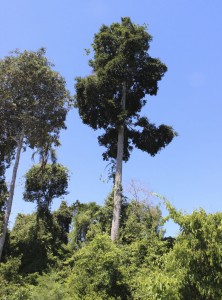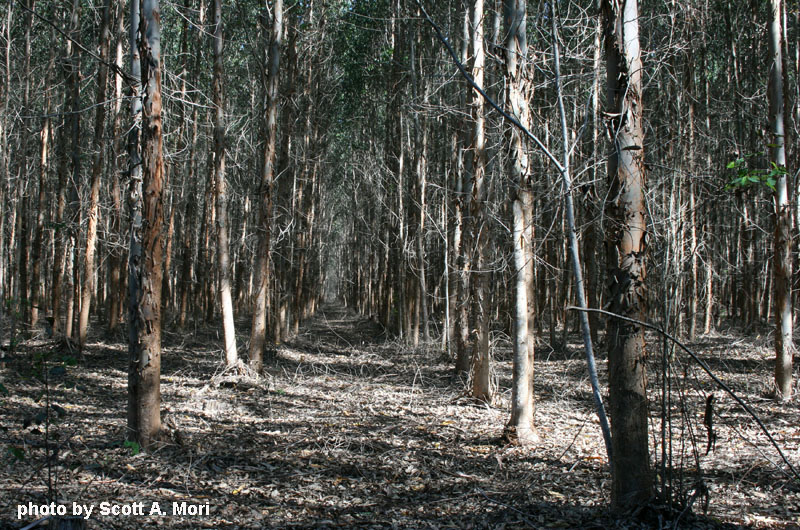Journey to Brazil: Finding Only One Where Once There Were Many
Posted in Travelogue on December 18, 2013 by Scott Mori
Scott A. Mori, Ph.D., is the Nathaniel Lord Britton Curator of Botany at The New York Botanical Garden. Nate Smith is an Honorary Research Associate at the Botanical Garden, and Fernando Matos is a Ph.D. student of the Garden’s Institute of Systematic Botany. Michel Ribeiro is a student at the Universidade Federal de Espírito Santo, Brazil, and Anderson Alves-Araújo serves as one of his advisers. This is the last in a three-part series documenting Dr. Mori’s recent trip to Brazil.

As I wrote in my last post, my colleagues and I recently searched for species of the Brazil nut family in the fragmented Atlantic coastal forests of the Brazilian state of Espírito Santo. There are only 12 species of this family (whose scientific name is Lecythidaceae) in the entire state, but some of the species in northern Espírito Santo are endemic, meaning they are found only there. The goal of our field work was to evaluate the conservation status of Lecythidaceae in this biologically rich but endangered part of Brazil.
A study published in 1981 suggested that 53.5 percent of the tree species growing in the Atlantic forest of eastern Brazil are endemic to that region. Evidence from bird, reptile, primate, and butterfly distributions supports the hypothesis that the coastal forest of eastern Brazil is a center of endemism for animals as well as plants. But large-scale deforestation, which began when early colonists cleared forests to establish sugar cane plantations, has reduced the original coastal forest to less than 10 percent of its original extent in some places. Because of this, the region has been classified as one of the world’s biodiversity hotspots, and the Brazilian government has made considerable efforts to protect what forests are left.

Espírito Santo, which is north of Rio de Janeiro, exhibits a beautiful mosaic of agricultural fields and plantations, especially during the rainy season. Spreading over vast areas, the dark green shrubs of coffee plantations and the lighter green crowns and slender trunks of cultivated, non-native eucalyptus trees are impressive. Cattle pasture and fields of papaya, black pepper, sugar cane, sweet manioc, corn, macadamia, rubber, and banana are interspersed among the coffee and eucalyptus plantations. Apart from the few small biological reserves, there are no stands of undisturbed old growth forest anywhere. Forests with many different tree species have been replaced by monocultures of coffee such as that seen in the accompanying image of a maçaranduba tree (Manilkara bella of the plant family Sapotaceae) towering above the coffee plants surrounding it. This landscape has been so drastically modified that places which once included hundreds of tree species in just a couple of acres now often harbor only one—the species under cultivation!
The fast-growing eucalyptus tree, which is native to Australia, is an unbelievably productive source of timber and pulp wood. The technology developed to plant the seeds, maintain the plantations weed-free, trim the lower branches, and cut and transport the logs to paper mills is exceedingly efficient and astonishing to witness. For an example, click here to see the way eucalyptus logs are harvested.

Six of the 12 known species of the Brazil nut family in Espírito Santo are threatened with extinction because they are found only in the area around Rio de Janeiro, in remnant forests in Espírito Santo, and in the southern part of the state of Bahia just to the north of Espírito Santo. We are grateful that Brazilian conservationists are doing what they can to protect remaining forests and hope that what we have discovered about species of the Brazil nut family on our expedition demonstrates how important it is to protect the remaining forest before the only trees that are left arise here and there from a landscape covered by cultivated plants.
Support for our visits to herbaria and for field work in eastern Brazil was provided by the Mohamed bin Zayed Species Conservation Fund, the Federal University of Espiríto Santo, the School of Tropical Botany of the Rio de Janeiro Botanical Garden, and the INCT-Virtual Herbário da Flora e dos Fungos of the Brazilian Instituto Nacional de Ciência e Technologia.

